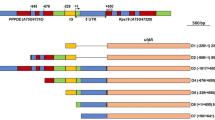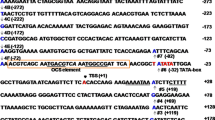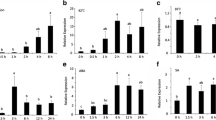Abstract
The rpL34 gene, which encodes a cytoplasmic ribosomal protein with a high homology to the rat 60S r-protein L34, was isolated from a genomic library of tobacco (Nicotiana tabacum L. cv. Xanthi-nc). A 1500 bp upstream promoter fragment was fused to the chloramphenicol acetyltransferase (CAT) reporter gene or β-glucuronidase (GUS) reporter gene and transferred into tobacco plants by the Agrobacterium-mediated leaf disk transformation method. Analysis of CAT activity in leaf tissues showed that mechanical wounding increased the rpL34 promoter activity about 5 times as compared to untreated controls and that the promoter activity was further enhanced by plant growth regulators, 2,4-dichlorophenoxyacetic acid and benzyladenine. Histochemical GUS staining patterns of the transgenic plants showed that the rpL34 promoter activity is high in actively growing tissues, including various meristems, floral organs, and developing fruits. A series of 5′ deletion analyses of the rpL34 promoter indicated that a 50 bp region located between −179 and −129 is essential for wound, auxin and cytokinin responses. Deletion of this region reduced the promoter activity to an undetectable level. Insertion of the 50 nucleotide sequence into a minimal promoter restored the promoter activity and the promoter strength was proportional to the copy number of the upstream sequence. The role of TATA and CAAT box regions was studied by a series of 3′ deletion analyses. A 3′ deletion up to −28 did not significantly affect the promoter strength. However deletion of the promoter up to 70 bp, which deleted the TATA box region, significantly reduced promoter activity. Further deletion of the promoter up to −104, eliminating the CAAT box region, abolished the promoter activity. These results suggest that the TATA box and CAAT box regions are also important for the rpL34 promoter activity in addition to the 50 bp upstream region.
Similar content being viewed by others
References
An G: Binary Ti vectors for plant transformation and promoter analysis. Meth Enzymol 153: 293–305 (1987).
An G, Ebert PR, Mitra A, Ha SB: Binary vectors. In: Gelvin SB, Schilperoort RA (eds) Plant Molecular Biology Manual, pp. A3/1–19. Kluwer Academic Publishers, Dordrecht, Netherlands (1988).
Benfey PN, Chua N-H: The cauliflower mosaic virus 35S promoter: combinational regulation of transcription in plants. Science 250: 959–966 (1990).
Bonham-Smith PC, Oancia TL, Moloney MM: Cytoplasmic ribosomal protein S15a from Brassica napus: molecular cloning and developmental expression in mitotically active tissues. Plant Mol Biol 18: 909–919 (1992).
Casadaban MJ, Cohen SN: Analysis of gene control signals by DNA fusion and cloning in Escherichia coli. J Mol Biol 138: 179–207 (1980).
Choi D, Yun HK, Bok S-H, Kim S-U: Nucleotide sequence of a cDNA encoding ribosomal protein L31 (GenBank U23784) from Nicotiana glutinosa L. (PGR95–028). Plant Physiol 108: 1748 (1995).
Chisholm D: A convenient moderate-scale procedure for obtaining DNA from bacteriophage lambda. Biotechniques 7: 21–23 (1989).
Ebert PR, Ha SB, An G: Identification of an essential upstream element in the nopaline synthase promoter by stable and transient assays. Proc Natl Acad Sci USA 84: 5745–5749 (1987).
Ellis JG, Llewellyn DJ, Walker JC, Dennis ES, Peacock WJ: The ocs elements: a 16 base pair palindrome essential for activity of the octopine synthase enhancer. EMBO J 6: 3203–3208 (1987).
Frischauf A, Lehrach H, Poustka A, Murray N: Lambda replacement vectors carrying polylinker sequences. J Mol Biol 170: 827–842 (1983).
Gantt JS, Key JL: Coordinated expression of ribosomal proteins in RNAs following auxin treatment of soybean hypocotyles. J Biol Chem 260: 6175–6181 (1985).
Gantt JS, Key JL: Auxin induced changes in the level of translatable ribosomal protein messenger ribonucleic acids in soybean hypocotyl. Biochemistry 22: 4131–4139 (1983).
Gantt JS, Thompson MD: Plant cytosolic ribosomal protein S11 and chloroplast ribosomal protein CS17. J Biol Chem 265: 2763–2767 (1990).
Gao J, Kim S-R, Chung Y-Y, Lee JM, An G: Developmental and environmental regulation of two ribosomal protein genes in tobacco. Plant Mol Biol 25: 761–770 (1994).
Gao J, Kim S-R, Lee JM, An G: Nucleotide and protein sequences of 60S ribosomal protein L17 from tobacco (Nicotiana tabacumL). Plant Physiol 103: 1027–1028 (1993).
Hoekema A, Hirsch PR, Hooykaas PJJ, Schilperoort RA: A binary vector strategy based on separation of vir-and T-region of the Agrobacterium tumefaciens Ti-plasmid. Nature 303: 179–181 (1983).
Jefferson RA, Kavanagh TA, Bevan MW: GUS fusions \-glucuronidase as a sensitive and versatile gene fusion marker in higher plants. EMBO J 6: 3901–3907 (1987).
Joanin P, Gigot C, Philipps G: cDNA nucleotide sequence and expression of a maize cytoplasmic ribosomal protein S13 gene. Plant Mol Biol 21: 701–704 (1993).
Kidou S, Umeda M, Kato A, Uchimiya H: Plant cDNA homologue to rat insulinoma gene encoding ribosomal protein S15. Nucl Acids Res 21: 2013 (1993).
Kim Y, Buckley K, Costa M, An G: A 20 nucleotide upstream element is essential for the nopaline synthase (nos) promoter activity. Plant Mol Biol 24: 105–117 (1994).
Kim S-R, Choi J-L, Costa MA, An G: Identification of G-box sequence as an essential element for methyl jasmonate response of potato proteinase inhibitor II promoter. Plant Physiol 99: 627–631 (1992).
Kim J-K, Wu R: A rice (Oryza sativa L.) cDNA encodes a protein sequence homologous to the eukaryotic ribosomal 5S RNA-binding protein. Plant Mol Biol 23: 409–413 (1993).
Kim Y, Zhahn H, Scholl RL: Two evolutionary divergent genes encode a cytoplasmic ribosomal protein of Arabidopsis thaliana. Gene 93: 177–182 (1990).
Köhler S, Coraggio I, Becker D, Salamini F: Pattern of expression of meristem-specific cDNA clones of barley (Hordeum vulgare L.). Planta 186: 227–235 (1992).
Larkin CJ, Hunsperger JP, Culley D, Rubenstein I, Silflow CD: The organization and expression of maize ribosomal protein gene family. Genes Devel 3: 500–509 (1989).
Lebrun M, Freyssinet G: Nucleotide sequence and characterization of a maize cytoplasmic ribosomal protein S11 cDNA. Plant Mol Biol 17: 265–268 (1991).
Lijsebettens MV, Vanderhaeghen R, Block MD, Bauw G, Villarroel R, Montagu MV: An S18 ribosomal protein gene copy at the Arabidopsis PFL locus affects plant development by its specific expression in meristems. EMBO J 13: 3378–3388 (1994).
Lindahl L, Zengel JM: Ribosomal genes in Escherichia coli. Annu Rev Genet 20: 297–326 (1986).
Liu J-H, Reid DM: a cDNA clone (accession No. L31645) homologous to human ribosomal protein S3a from sunflower (Helianthus annuus) seedlings (PGR95–050). Plant Physiol 109: 338 (1995).
Madsen LH, Kreiberg JD, Gausing K: A small gene family in barley encodes ribosomal proteins homologous to yeast YT17 and L22 from archaebacteria and chloroplast. Curr Genet 19: 417–422 (1991).
Mager WH: Control of ribosomal protein gene expression. Biochim Biophys Acta 949: 1–15 (1988).
Marty I, Meyer Y: cDNA nucleotide sequence and expression of a tobacco cytoplasmic ribosomal protein L2 gene. Nucl Acids Res 20: 1517–1522 (1992).
Nakamura I, Kameya N, Aoki T, Tada T, Norita E, Kanzaki H, Uchimiya H: Nucleotide sequence of a rice cDNA encoding a homologue of the eukaryotic ribosomal protein S8. Plant Physiol 107: 1463–1464 (1995).
Nishi R, Kidou S, Uschimiya H, Kato A: The primary structure of two proteins from the large ribosomal subunit of rice. Biochim Biophys Acta 1216: 110–112 (1993).
Nomura M, Gourse R, Baughman G: Regulation of the synthesis of ribosomes and ribosomal components. Annu Rev Biochem 53: 75–118 (1984).
Perez L, Aguilar R, Mendez AP, de Jimenez ES: Phosphorylation of ribosomal proteins induced by auxins in maize embryonic tissues. Plant Physiol 94: 1270–1275 (1990).
Planta RJ, Raue HA: Control of ribosome biogenesis in yeast. Trends Genet 4: 64–68 (1988).
Sangwan V, Lenvik TR, Gantt JS: The Arabidopsis thaliana ribosomal protein S15 (rig) gene. Biochim Biophys Acta 1216: 211–226 (1993).
Somers DE, Quail PH: Temporal and spatial expression patterns of PHYA and PHYB genes in Arabidopsis thaliana Plant J 7: 413–427 (1995).
Stafstrom JP, Sussex I: Expression of a ribosomal protein gene in axillary buds of pea seedlings. Plant Physiol 100: 1494–1502 (1992).
Taylor MA, Arif SAM, Pearce SR, Davies HV, Kumar A, George LA: Differential expression and sequence analysis of ribosomal protein genes induced in stolon tips of potato (Solanum tuberosum L.) during the early stages of tuberization. Plant Physiol 100: 1171–1176 (1992).
Taylor MA, Davies H: Nucleotide sequence of a cDNA clone for a 60S ribosomal protein L27 gene from potato (Solanum tuberosum L.). Plant Physiol 105: 1025–1028 (1994).
Ulmasov T, Liu Z-B, Hagen G, Guilfoyle TJ: Composite structure of auxin response elements. Plant Cell 7: 1611–1623 (1995).
Warskulat U, Perrey R, Wink M: Molecular cloning a cDNA from cell cultures encoding a ribosomal protein (rps 16). Plant Mol Biol 16: 739–740 (1990).
Williams ME, Sussex IM: Developmental regulation of ribosomal protein L16 genes in Arabidopsis thaliana. Plant J 8: 65–76 (1995).
Wool IG, Endo Y, Chan YL, Gluck A: Studies of the structure, function, and evolution of mammalian ribosomes. In: Hill WE, Dahlberg A, Garrett RA, Moore PB, Schlessinger D, Warner JR (eds) Ribosome Structure, Function, and Evolution, pp. 203–214. American Society for Microbiology, Washington, DC (1990).
Zhao Y, Watson JC, Kung S, Bottino PJ: Characterization of a cDNA encoding ribosomal protein S16 in rice. Plant Physiol 107: 1471–1472 (1995).
Author information
Authors and Affiliations
Rights and permissions
About this article
Cite this article
Dai, Z., Gao, J., An, K. et al. Promoter elements controlling developmental and environmental regulation of a tobacco ribosomal protein gene L34 . Plant Mol Biol 32, 1055–1065 (1996). https://doi.org/10.1007/BF00041389
Received:
Accepted:
Issue Date:
DOI: https://doi.org/10.1007/BF00041389




